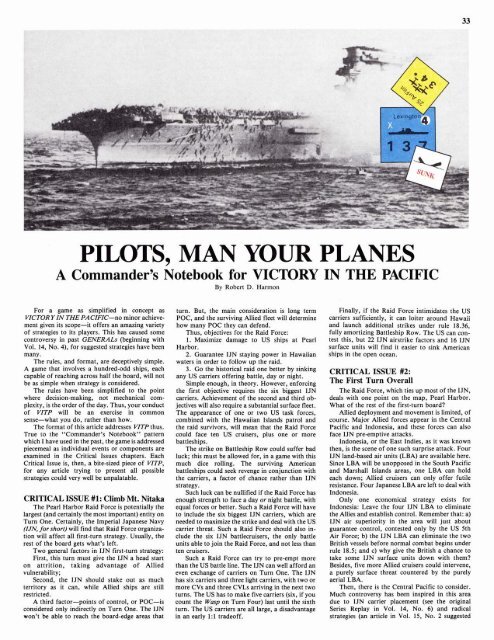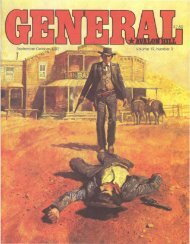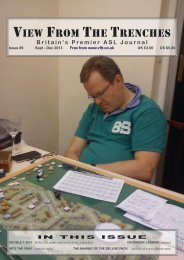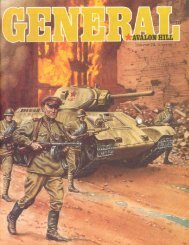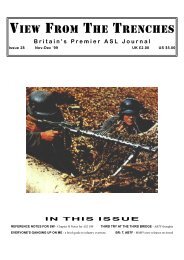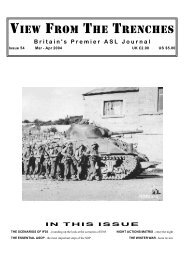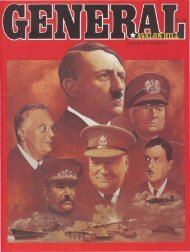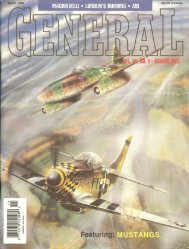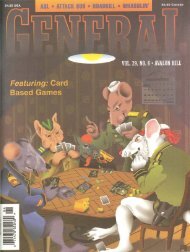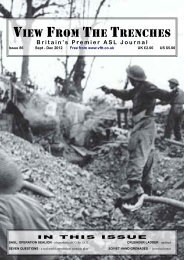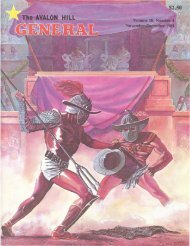18.64MB - View From The Trenches
18.64MB - View From The Trenches
18.64MB - View From The Trenches
- TAGS
- trenches
- www.vftt.co.uk
You also want an ePaper? Increase the reach of your titles
YUMPU automatically turns print PDFs into web optimized ePapers that Google loves.
PILOTS, MAN YOUR PLANES<br />
A Commander's Notebook for VICTORY IN THE PACIFIC<br />
By Robert D. Harmon<br />
For a game as simplified in concept as<br />
VICTORY IN THE PACIFIC-no minor achieve-<br />
ment given its scope-it offers an amazing variety<br />
of strategies to its players. This has caused some<br />
controversy in past GENERALS (beginning with<br />
Vol. 14, No. 4), for suggested strategies have been<br />
many.<br />
<strong>The</strong> rules, and format, are deceptively simple.<br />
A game that involves a hundred-odd ships, each<br />
capable of reaching across half the board, will not<br />
be as simple when strategy is considered.<br />
<strong>The</strong> rules have been simplified to the point<br />
where decision-making, not mechanical com-<br />
plexity, is the order of the day. Thus, your conduct<br />
of VITP will be an exercise in common<br />
sense-what you do, rather than how.<br />
<strong>The</strong> format of this article addresses VITP thus.<br />
True to the "Commander's Notebook" pattern<br />
which I have used in the past, the game is addressed<br />
piecemeal as individual events or components are<br />
examined in the Critical Issues chapters. Each<br />
Critical Issue is, then, a bite-sized piece of VITP,<br />
for any article trying to present all possible<br />
strategies could very well be unpalatable.<br />
CRITICAL ISSUE #1: Climb Mt. Nitaka<br />
<strong>The</strong> Pearl Harbor Raid Force is potentially the<br />
largest (and certainly the most important) entity on<br />
Turn One. Certainly, the Imperial Japanese Navy<br />
(IJN, for short) will find that Raid Force organiza-<br />
tion will affect all first-turn strategy. Usually, the<br />
rest of the board gets what's left.<br />
Two general factors in IJN first-turn strategy:<br />
First, this turn must give the IJN a head start<br />
on attrition, taking advantage of Allied<br />
vulnerability;<br />
Second, the IJN should stake out as much<br />
territory as it can, while Allied ships are still<br />
restricted.<br />
A third factor-points of control, or POC-is<br />
considered only indirectly on Turn One. <strong>The</strong> IJN<br />
won't be able to reach the board-edge areas that<br />
turn. But, the main consideration is long term<br />
POC, and the surviving Allied fleet will determine<br />
how many POC they can defend.<br />
Thus, objectives for the Raid Force:<br />
1. Maximize damage to US ships at Pearl<br />
Harbor.<br />
2. Guarantee IJN staying power in Hawaiian<br />
waters in order to follow up the raid.<br />
3. Go the historical raid one better by sinking<br />
any US carriers offering battle, day or night.<br />
Simple enough, in theory. However, enforcing<br />
the first objective requires the six biggest IJN<br />
carriers. Achievement of the second and third ob-<br />
jectives will also require a substantial surface fleet.<br />
<strong>The</strong> appearance of one or two US task forces,<br />
combined with the Hawaiian Islands patrol and<br />
the raid survivors, will mean that the Raid Force<br />
could face ten US cruisers, plus one or more<br />
battleships.<br />
<strong>The</strong> strike on Battleship Row could suffer bad<br />
luck; this must be allowed for, in a game with this<br />
much dice rolling. <strong>The</strong> surviving American<br />
battleships could seek revenge in conjunction with<br />
the carriers, a factor of chance rather than IJN<br />
stratem.<br />
such luck can be nullified if the Raid Force has<br />
enough strength to face a day or night battle, with<br />
equal forces or better. Such a Raid Force will have<br />
to include the six biggest IJN carriers, which are<br />
needed to maximize the strike and deal with the US<br />
carrier threat. Such a Raid Force should also in-<br />
clude the six IJN battlecruisers, the only battle<br />
units able to join the Raid Force, and not less than<br />
ten cruisers.<br />
Such a Raid Force can try to pre-empt more<br />
than the US battle line. <strong>The</strong> IJN can well afford an<br />
even exchange of carriers on Turn One. <strong>The</strong> IJN<br />
has six carriers and three light carriers, with two or<br />
more CVs and three CVLs arriving in the next two<br />
turns. <strong>The</strong> US has to make five carriers (six, if you<br />
count the Wasp on Turn Four) last until the sixth<br />
turn. <strong>The</strong> US carriers are all large, a disadvantage<br />
in an early 1:l tradeoff.<br />
Finally, if the Raid Force intimidates the US<br />
carriers sufficiently, it can loiter around Hawaii<br />
and launch additional strikes under rule 18.36,<br />
fully amortizing Battleship Row. <strong>The</strong> US can con-<br />
test this, but 22 IJN airstrike factors and 16 IJN<br />
surface units will find it easier to sink American<br />
ships in the open ocean.<br />
CRITICAL ISSUE #2:<br />
<strong>The</strong> First Turn Overall<br />
<strong>The</strong> Raid Force, which ties up most of the IJN,<br />
deals with one point on the map, Pearl Harbor.<br />
What of the rest of the first-turn board?<br />
Allied deployment and movement is limited, of<br />
course. Major Allied forces appear in the Central<br />
Pacific and Indonesia, and these forces can also<br />
face IJN pre-emptive attacks.<br />
Indonesia, or the East Indies, as it was known<br />
then, is the scene of one such surprise attack. Four<br />
IJN land-based air units (LBA) are available here.<br />
Since LBA will be unopposed in the South Pacific<br />
and Marshall Islands areas, one LBA can hold<br />
each down; Allied cruisers can only offer futile<br />
resistance. Four Javanese LBA are left to deal with<br />
Indonesia.<br />
Only one economical strategy exists for<br />
Indonesia: Leave the four IJN LBA to eliminate<br />
the Allies and establish control. Remember that: a)<br />
IJN air superiority in the area will just about<br />
guarantee control, contested only by the US 5th<br />
Air Force; b) the IJN LBA can eliminate the two<br />
British vessels before normal combat begins under<br />
rule 18.5; and c) why give the British a chance to<br />
take some IJN surface units down with them?<br />
Besides, five more Allied cruisers could intervene,<br />
a purely surface threat countered by the purely<br />
aerial LBA.<br />
<strong>The</strong>n, there is the Central Pacific to consider.<br />
Much controversy has been inspired in this area<br />
due to IJN carrier placement (see the original<br />
Series Replay in Vol. 14, No. 6) and radical<br />
strategies (an article in Vol. 15, No. 2 suggested


